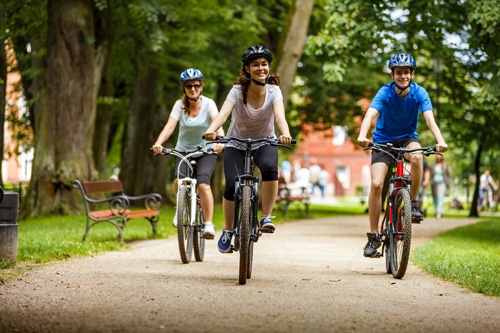
Bike Lanes and Vibrant Colors on and off Your Bike Help Keep You Safe!
There are more cyclists on today’s roads than ever before, as the sport’s popularity has grown immensely over the past few years. Whether you’re out for a joy ride or looking to shorten your commute to work, cycling can be a great way to raise your heart rate while also saving money. Regardless of why you choose to pedal around, it’s critical that you understand the importance of cycling safety. Unfortunately, as a cyclist, you don’t own the road. Instead, you must share it with trucks, cars, buses, and numerous other variables that can inflict serious harm. Cyclists face a unique challenge out on the streets, as most of their risk elements come from external sources, making it imperative that cyclist adapt to the conditions around them. As well, many cyclists are “clipped in” to their pedals, making split-second reflex situations even more treacherous.
The increase in road cycling has also lead to an increase in accidents. In most cases, these accidents are completely avoidable and are the product of careless operation. When most people think of bike safety, they think of wearing a helmet. While wearing a helmet is crucially important and helps save lives in the event of an accident, the goal of cycling should be to avoid accidents in the first place. Bicycling should be a fun activity, though it can also be inherently dangerous. To help keep you and your family safe and smiling on two wheels, we’ve put together a list of information and best practices regarding cycling operation.
Before You Hit the Pavement
-
Take a bicycle safety course or prepare yourself by watching safety videos online.
-
The League of American Bicyclists is a great resource for cyclists across the country looking for a safety class or online videos.
-
Check your local laws.
-
Each state has their own set of specific laws pertaining to cycling operation. Becoming familiar with your state’s local bicycling laws can help you avoid accidents and handle them appropriately if one does occur.
-
Inspect your equipment!
-
Make sure you ride a bike that fits your body. The better the fit, the better control you will have on the road.
-
Helmets, helmets, helmets! Choose an appropriate-sized helmet with a snug fit and ample padding; it could save your life!
-
Check your brakes and handle bars to get a feel for how responsive they are. Each bike will have a different feel. It’s important to gain an understanding of how quickly you can stop or turn before heading out.
-
Put on reflective equipment and highly visible clothing. Be an eye-sore—the more you stand out, the less likely you will be hit.
-
If you plan on going out at night, double check to see that you have working lights on both the front and back of your bike. And wear reflective gear.
-
Plan your trip carefully.
-
Choose a route that has bike lanes, such as our Color-Safe® bike lanes. Our green-colored bike lanes communicate to road users that within the vividly colored area is a portion of the road that’s been dedicated to the use of cyclists. Brightly colored bike lanes that are clearly delineated with durable, skid-resistant pavement markings keep cyclists visible and reduce the likelihood of an accident.
-
-
Try your best to avoid routes on high-traffic roads with small shoulders. Construction areas should also be considered a no-go for cyclists, as your risk of injury increases exponentially in these zones.
-
Pick your timing wisely. In most cases, rush hour is the most dangerous time to ride. According to NHTSA Fact Sheet statistics show that most fatal bike accidents happen between 6 and 9 p.m.
While on the Road
-
Follow the rules of the road, duh!
-
Just because you’re not in a car doesn’t mean you get to blast through stop signs and disregard pedestrians. Adhere to traffic rules just as you would in a car. Always stop at red lights and stop signs—and use your hands to signal direction. Remember that pedestrians still have the right-of-way—and yield accordingly.
-
Keep as far right as possible and stay in those bike lanes!
-
Generally, while riding you should stay within bike lanes whenever possible. On roads without designated bike lanes, stay as far right as possible and ride with traffic, not against it.
-
Never assume a motorist has seen you.
-
Think of all the times you’ve been driving a car and have been distracted. Just because you can see a driver doesn’t mean they can see you. Be extremely cautious and make eye contact whenever possible.
-
Be wary passing parked cars.
-
Parked cars can pose a massive danger to you as a cyclist. Sudden opening of doors is one of the leading causes of injury in the cycling world. Riding tight along parked cars to avoid traffic is a mistake; you’re much more likely to get “doored” than hit from behind. Additionally, keep an eye out for cars backing out of spaces or leaving blind driveways.
-
Keep the use of electronics to a minimum.
-
Never use your cell phone while on the road, period.
-
Want to listen to your tunes while out cycling? Go ahead, but either use a portable speaker or always keep one earphone out to hear what’s going on around you.
-
Uncomfortable? Walk it off.
-
If you encounter a busy intersection you’re nervous about pedaling through, just get off and walk your bike across.
A Good Defense Is Your Best Offense!
As a general best practice while biking, defense is your best offense. Cyclists should be hyper-defensive and realize that the right-of-way won’t prevent them from getting hit by an inattentive driver. On two wheels there is no room for aggression because when an accident occurs between a car and bicycle, it’s almost always the cyclists that gets hurt. If you do happen to get in an accident, seek out experienced legal representatives who understand the cycling point of view and your insurance options.
All of this may sound a bit overwhelming but if you follow the rules, you will minimize your chance of injury. You starting cycling for fun, right? Well go out and enjoy it! Just remember to remain vigilant, cautious, and within those bright green Color-Safe® bike lanes!
If you are active in your local cycling community or are a Department of Transportation official and want to learn more about how Transpo has helped municipalities and organizations create safer bike and pedestrian lanes with our proprietary, vibrantly colored Color-Safe® pavement markings, take a look at our portfolio to get a closer look at what your community might look like with safer bike and pedestrian lanes!

